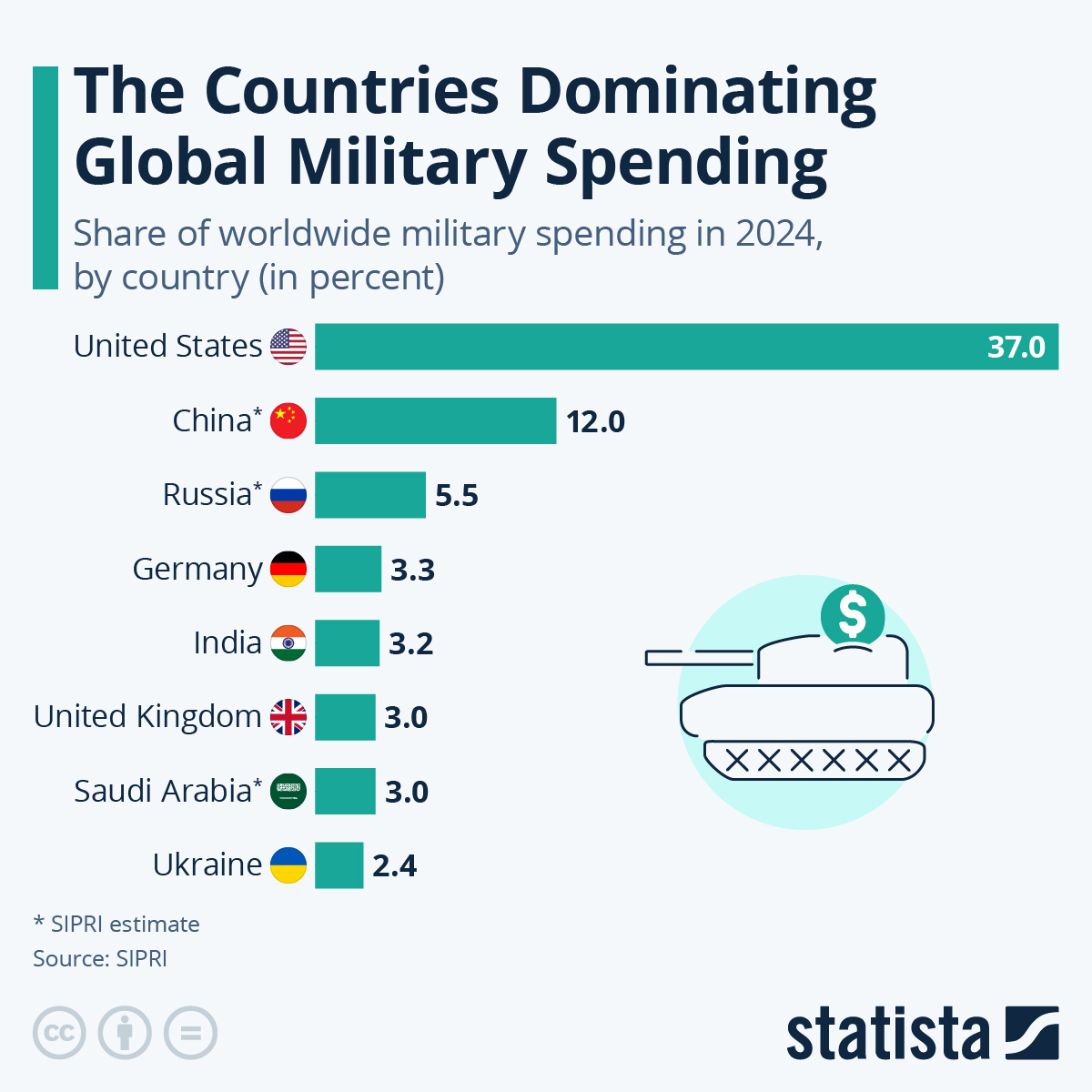Europe's Military Buildup: A Surge In Global Defense Spending

Table of Contents
Geopolitical Drivers of Europe's Military Buildup
Europe's renewed focus on military strength is largely a response to evolving geopolitical realities. Several factors contribute to this significant increase in defense spending and military modernization efforts.
The War in Ukraine as a Catalyst
The 2022 Russian invasion of Ukraine served as a brutal wake-up call for European nations. The conflict shattered the prevailing post-Cold War security assumptions and exposed vulnerabilities in European defenses. This led to a dramatic reassessment of security needs and a subsequent surge in defense budgets.
- Increased defense budgets across NATO countries: Many NATO members, particularly those bordering Russia, have pledged to significantly increase their defense spending, exceeding the NATO target of 2% of GDP.
- Specific examples of increased spending: Poland has dramatically increased its military budget, investing heavily in new equipment and personnel. Germany, after years of underinvestment, has embarked on a substantial military modernization program.
- Shifts in military strategy: The war in Ukraine has underscored the need for enhanced defensive capabilities, including improved air defense systems, anti-tank weaponry, and cyber security measures. This is reflected in updated military doctrines and procurement strategies. According to the Stockholm International Peace Research Institute (SIPRI), European military expenditure increased by 13% in 2022.
The Rise of Russia and its Implications for European Security
Russia's increasingly assertive foreign policy, including its annexation of Crimea in 2014 and the ongoing war in Ukraine, poses a direct threat to European security. This has prompted a significant response from European nations and NATO.
- Examples of Russian aggression: Beyond Ukraine, Russia's military interventions in Georgia (2008) and Syria, along with its cyber warfare activities and disinformation campaigns, demonstrate a willingness to use force to achieve its geopolitical objectives.
- NATO's response: NATO has reinforced its eastern flank, deploying troops and equipment to reassure its allies and deter further Russian aggression. This includes increased military exercises and enhanced intelligence sharing.
- Development of new defense capabilities: European nations are investing in advanced weaponry and military technology to counter Russia's military capabilities. This includes investments in air defense, missile defense, and cyber warfare capabilities.
Concerns about China's Growing Military Power
The rise of China as a global power, coupled with its expanding military capabilities, is another significant factor contributing to Europe's military buildup. Concerns about China's technological advancement and assertive territorial claims in the South China Sea are shaping European defense strategies.
- China's military expansion: China's military modernization program is rapidly expanding its naval, air, and space capabilities. This includes the development of advanced weapons systems and a growing blue-water navy.
- Concerns about technological competition: Europe is increasingly concerned about China's technological prowess, particularly in areas such as artificial intelligence, 5G technology, and cyber warfare. This is fueling efforts to develop indigenous technological capabilities and strengthen cybersecurity measures.
- European strategies to counter Chinese influence: European nations are increasingly seeking to cooperate on defense and security issues, aiming to counter China's growing influence through diplomatic means and strategic partnerships. This includes collaboration with like-minded countries and international organizations.
Key Aspects of Europe's Military Modernization
Europe's military buildup is not merely about increasing spending; it involves a comprehensive modernization of its armed forces and defense capabilities.
Investment in New Technologies and Weapon Systems
European nations are investing heavily in advanced military technologies and new weapons systems to enhance their defense capabilities.
- Examples of new weapons systems being acquired: This includes investments in next-generation fighter jets, advanced missile systems, unmanned aerial vehicles (UAVs), and sophisticated cyber warfare tools. Many countries are procuring new tanks, such as the Leopard 2.
- Increased investment in cyber security: Cybersecurity is becoming increasingly important as nations recognize the growing threat of cyberattacks. Investment in cybersecurity infrastructure and training is a key aspect of military modernization.
- Focus on artificial intelligence and drone technology: Artificial intelligence (AI) and drone technology are transforming warfare, and European nations are investing heavily in these areas to enhance their military capabilities.
Strengthening Military Alliances and Cooperation
The increased cooperation between European nations and within NATO is a key element of Europe's military buildup. This involves enhanced military exercises, improved intelligence sharing, and increased interoperability of armed forces.
- Enhanced joint military exercises: Regular joint military exercises involving multiple European nations and NATO allies are designed to improve interoperability and enhance readiness.
- Improved intelligence sharing: Improved intelligence sharing amongst allies is crucial for effective defense and threat assessment.
- Increased interoperability between armed forces: Efforts are underway to standardize equipment and procedures to ensure seamless cooperation between different national armed forces. The European Union is also playing a growing role in defense cooperation.
Increased Military Personnel and Training
Many European countries are increasing the size of their militaries and investing more in military training and personnel development.
- Recruitment campaigns: Several countries are launching recruitment campaigns to attract new recruits and boost the size of their armed forces.
- Increased military budgets allocated to training: Significant portions of increased defense budgets are allocated to enhance training programs and develop specialized skills.
- Focus on specialized skills: Modern warfare demands specialized skills in areas like cyber warfare, artificial intelligence, and special operations. European militaries are investing in training to develop these skills.
The Global Implications of Europe's Military Buildup
Europe's military buildup has significant global implications, affecting global defense spending and reshaping geopolitical alliances.
Impact on Global Defense Spending
The surge in European defense spending is a significant factor in the overall global defense landscape.
- Comparisons with other major global defense spenders: While the US remains the world's largest military spender, Europe's increased spending is changing the balance of power. China's military budget is also a significant factor in this equation.
- Potential for an arms race: The increase in defense spending in Europe could lead to a regional or even global arms race, potentially destabilizing the international security environment. However, it could also strengthen deterrence.
Geopolitical Realignments and Shifting Power Dynamics
Europe's military buildup is impacting global geopolitical alliances and power dynamics.
- Potential shifts in alliances: The renewed emphasis on military strength could lead to shifts in alliances and partnerships.
- Impact on regional conflicts: Europe's strengthened military capacity could influence the dynamics of regional conflicts, both within Europe and beyond.
- Implications for international relations: The increased military spending could lead to increased tension between major powers, affecting international relations and potentially leading to greater geopolitical instability.
Conclusion: Europe's Military Buildup: A Shifting Global Landscape
Europe's military buildup, driven by the war in Ukraine, the rise of Russia and China, and a reassessment of global security, represents a fundamental shift in the European security architecture. This involves substantial increases in defense spending, significant modernization efforts focusing on new technologies, strengthened military alliances, and increased personnel and training. This trend has profound global implications, impacting global defense spending, potentially sparking arms races, and reshaping geopolitical alliances and power dynamics. Understanding the complexities of Europe's military buildup is crucial for analyzing the evolving global security landscape. Stay informed about the ongoing developments in Europe's military buildup by following reputable news sources, think tanks such as the International Institute for Strategic Studies (IISS) and SIPRI, and academic research. Understanding this trend is critical for navigating the complexities of the evolving global security environment.

Featured Posts
-
 Swq Alraklyt Fy Swysra Yshhd Tfrt Qyasyt
Apr 30, 2025
Swq Alraklyt Fy Swysra Yshhd Tfrt Qyasyt
Apr 30, 2025 -
 Gretna Development The Destination Nebraska Act And The Future Of The Rod Yates Project
Apr 30, 2025
Gretna Development The Destination Nebraska Act And The Future Of The Rod Yates Project
Apr 30, 2025 -
 Significant Disney Layoffs Impact Abc News Staff
Apr 30, 2025
Significant Disney Layoffs Impact Abc News Staff
Apr 30, 2025 -
 Cavaliers Vs Heat Game 2 Live Stream Tv Schedule And Viewing Guide
Apr 30, 2025
Cavaliers Vs Heat Game 2 Live Stream Tv Schedule And Viewing Guide
Apr 30, 2025 -
 Dont Pack These Essential Cruise Packing Tips
Apr 30, 2025
Dont Pack These Essential Cruise Packing Tips
Apr 30, 2025
Latest Posts
-
 Actor Michael Sheen Pays Off 1 Million In Debt For 900 Individuals
May 01, 2025
Actor Michael Sheen Pays Off 1 Million In Debt For 900 Individuals
May 01, 2025 -
 Analyzing The Six Nations Frances Success And The Emerging Lions Squad
May 01, 2025
Analyzing The Six Nations Frances Success And The Emerging Lions Squad
May 01, 2025 -
 Six Nations Review France Wins Despite Setbacks Lions Squad Takes Shape
May 01, 2025
Six Nations Review France Wins Despite Setbacks Lions Squad Takes Shape
May 01, 2025 -
 Embark On Arc Raiders Second Public Test Dates And Details
May 01, 2025
Embark On Arc Raiders Second Public Test Dates And Details
May 01, 2025 -
 Frances Six Nations Triumph Mauvakas Mistakes And Lions Implications
May 01, 2025
Frances Six Nations Triumph Mauvakas Mistakes And Lions Implications
May 01, 2025
